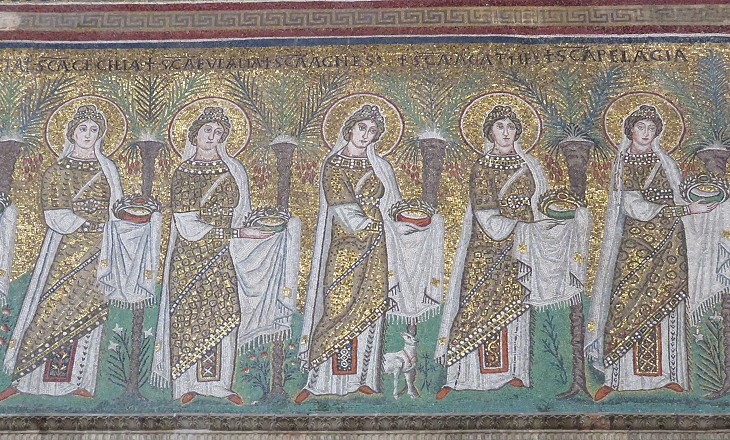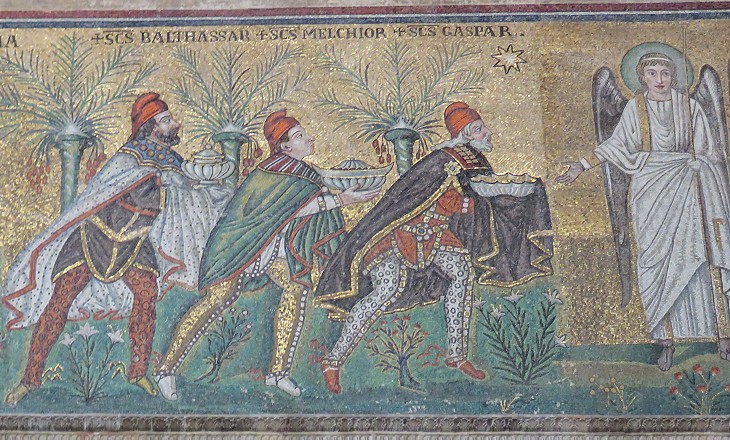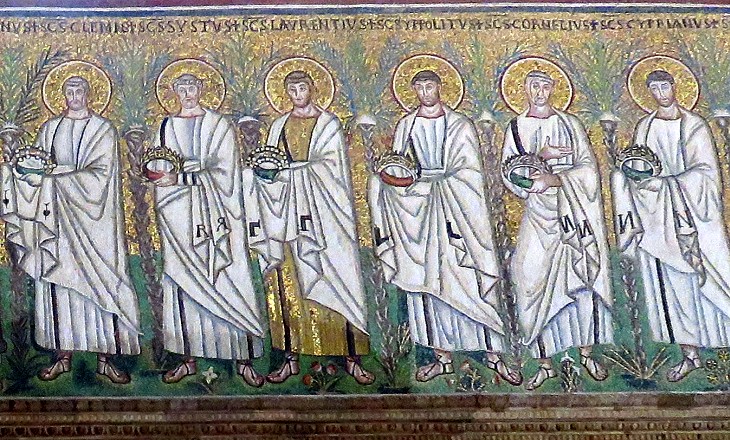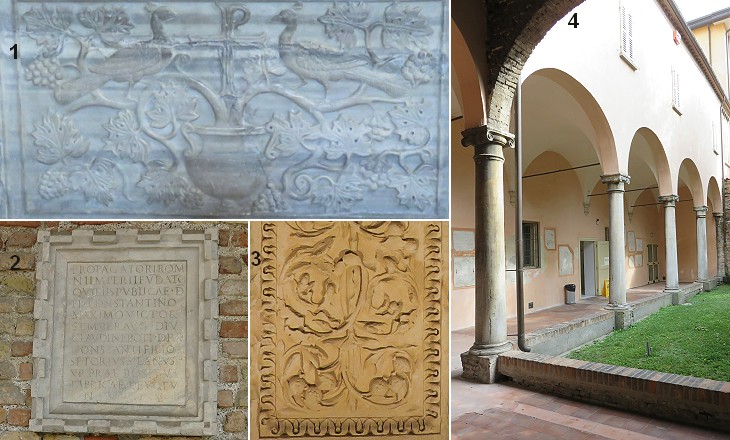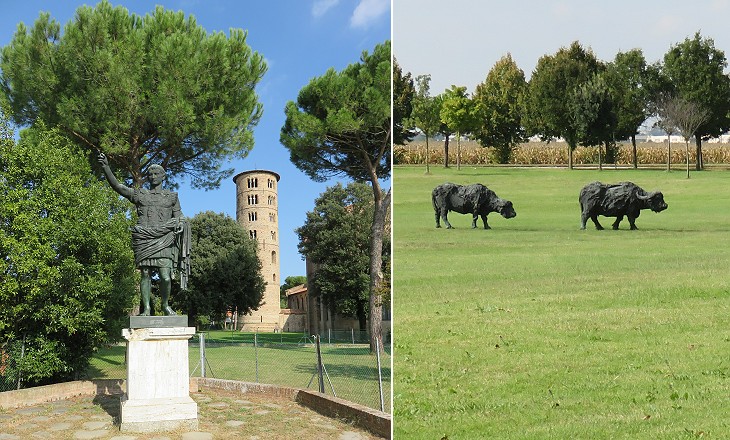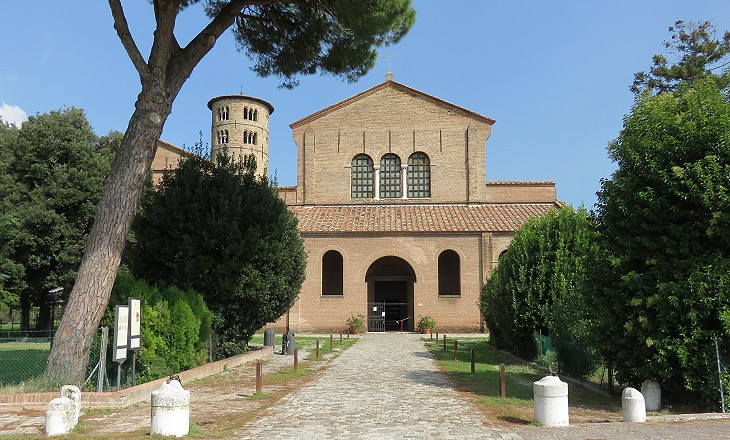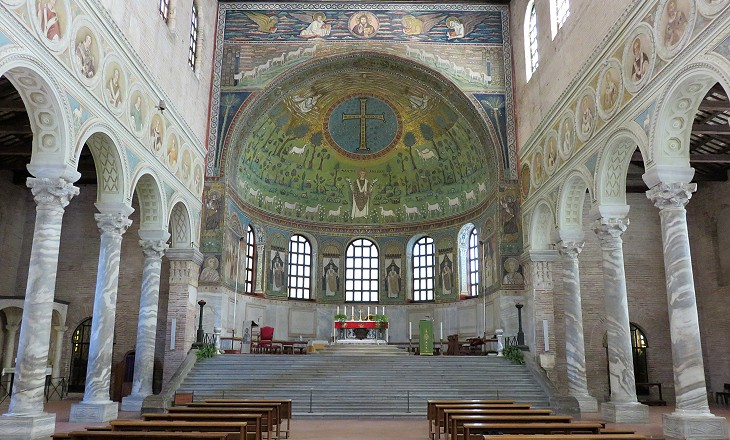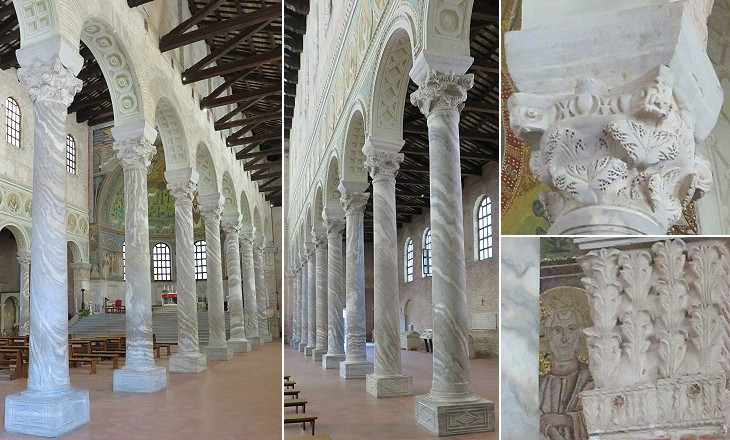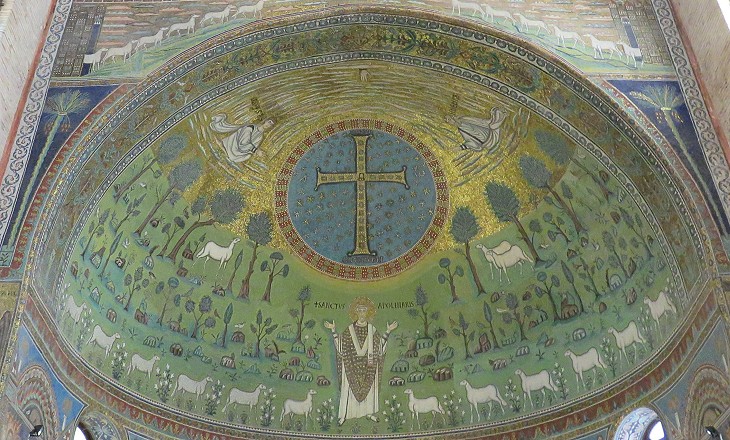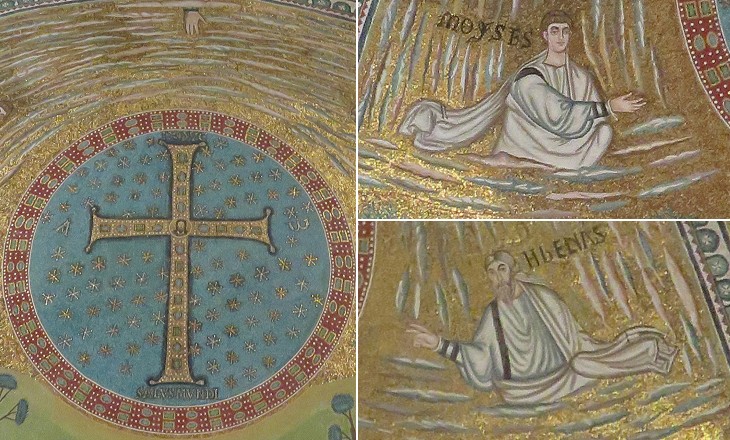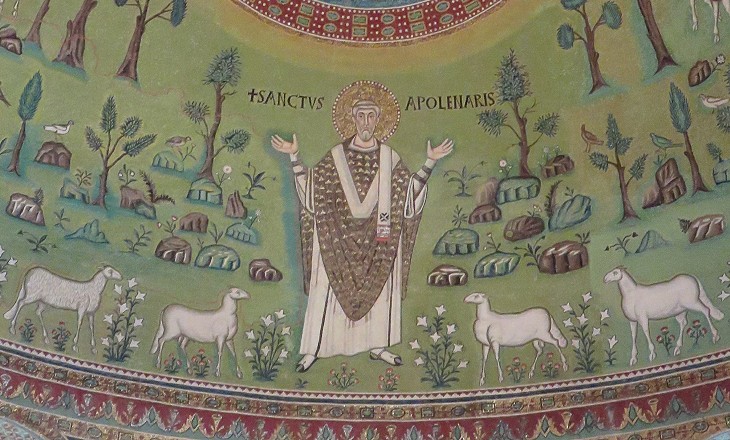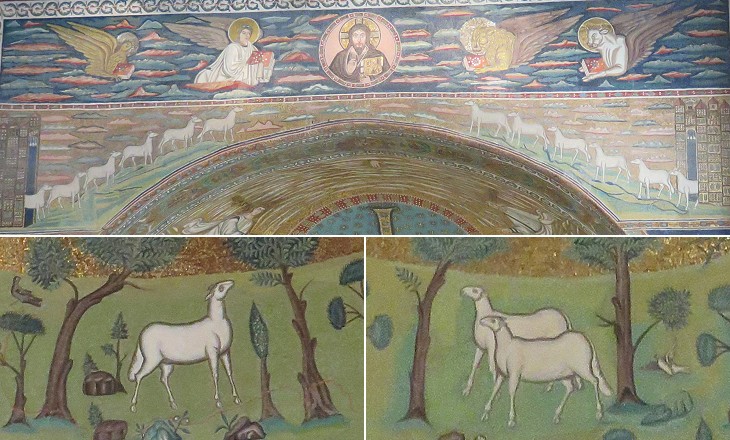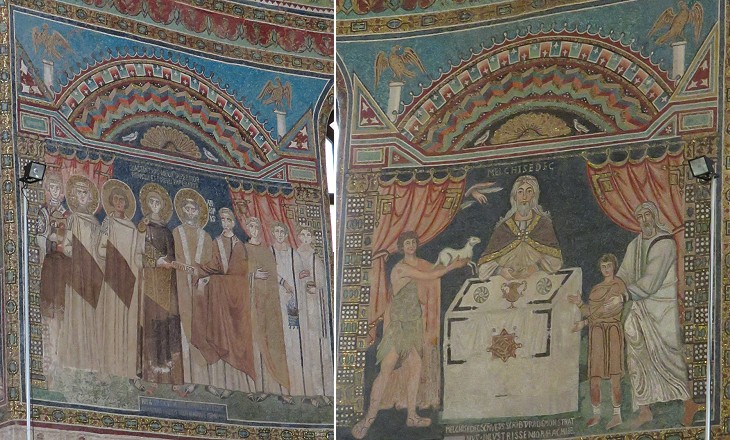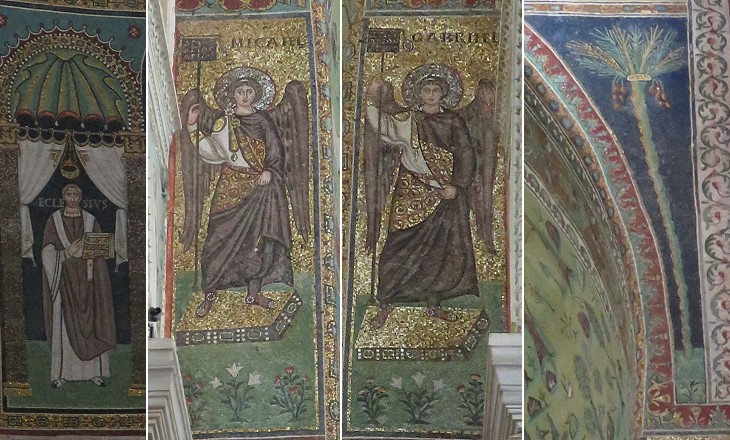  What's New! Detailed Sitemap All images © by Roberto Piperno, owner of the domain. Write to romapip@quipo.it. Text edited by Rosamie Moore. Page added in January 2015. |
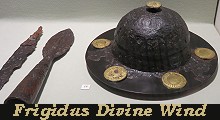 - Byzantine Ravenna: S. Apollinare in Classe - Byzantine Ravenna: S. Apollinare in Classe(Longobard weapons at Museo Archeologico di Cividale) You may wish to read an introduction to this section and a page covering Ostrogothic Ravenna first. This page covers S. Apollinare in Classe and some mosaics at S. Apollinare Nuovo which were made during the Byzantine rule.
In the storey below, processions of saints, men on the south side, women on the north, corresponding to the division of the sexes of the congregation below, occupy the whole length of the nave above the arcade. (..) What the Catholics found to object to in Theodoric's processions we cannot tell, but it is obvious that they destroyed them and substituted the monotonous figures we now see in their place. Thomas Graham Jackson - Byzantine and Romanesque Architecture - 1913 S. Apollinare Nuovo was built during the reign of King Theodoric as a church for the Ostrogothic/Arian community. Changes were made to the decoration of the church by the Byzantines after they conquered Ravenna in 540 and eradicated Arianism. The figures are relieved on a gold ground with dresses chiefly of white in which mother of pearl is introduced, and are divided by palm trees with green leaves and brown stems bearing red fruit. Each figure carries a crown, and is named, and has a nimbus, defined by a line forming a circle some way from the head. In the draperies gold is shaded with brown, and white with grey, and the white is defined against the gold on the shaded side by a black or dark brown line. The ground on which they stand is green. The 22 female saints on the north of the nave proceed eastward from the city of Classis towards the Virgin and Child who are enthroned at the far end. T. G. Jackson
Their procession is headed by the three kings, who in extravagant attitudes are hastening to offer their gifts. They are dressed in strange barbarian garb, with flowing mantles and embroidered trousers, the forbidden garments of the Goths. T. G. Jackson The Romans did not wear trousers; these were typical of the Dacians, the inhabitants of today's Romania, who were often portrayed in a costume similar to that of the Magi, but as prisoners of war. The Dacians however did not have embroidered trousers which were instead worn by people living near the eastern border of the Empire, such as the rich inhabitants of Palmyra or the Sassanid kings.
On the opposite side the 25 male saints proceed from the town of Ravenna, where is a representation of the "Palatium" of Theodoric, towards a figure of our Lord seated between four angels. The procession is headed by S. Martin to whom the church was dedicated, and who is distinguished by a purple dress instead of the usual white. The figures in these processions are conventional and have no variety, and are distinctly inferior both in design and execution to those above them; and they belong evidently to a different period. T. G. Jackson
The Byzantines dedicated the church to St. Martin of Tours, a strong opponent of Arianism. In the IXth century it acquired its current name when St. Apollinaris' relics were moved there from Classe. It underwent changes and additions in the following centuries and some of them will be covered in pages to be developed. In the XXth century the original aspect of S. Apollinare Nuovo was partly restored by reconstructing the balustrade which separated the altar from the nave. The cloister and the church house some ancient inscriptions and fragments of decoration. An inscription is of particular interest because it makes reference to Claudius II who ruled the Empire from September 268 to July 270, during a period of military anarchy. Emperor Constantine claimed to descend from that emperor in order to assert the legitimacy of his power.
No longer now upon thy swelling tide, Pine-forest-like, thy myriad galleys ride! For where the brass-beaked ships were wont to float, The weary shepherd pipes his mournful note; And the white sheep are free to come and go Where Adria's purple waters used to flow. Wilde had probably in mind the following rhymes by Lord Byron (Don Juan - Third Canto): Of the pine-forest, and the silent shore Which bounds Ravenna's immemorial wood, Rooted where once the Adrian wave flow'd o'er, To where the last Caesarean fortress stood, Evergreen forest!(..) How have I loved the twilight hour and thee! As early as the sixth century, the sea had already retreated to such a distance from Ravenna that orchards and gardens were cultivated on the spot where once the galleys of the Caesars rode at anchor. Groves of pines sprang up along the shore, and in their lofty tops the music of the wind moved like the ghost of waves and breakers plunging upon distant sands. This Pinetum stretches along the shore of the Adriatic for about forty miles, forming a belt of variable width between the great marsh and the tumbling sea. From a distance the bare stems and velvet crowns of the pine-trees stand up like palms that cover an oasis on Arabian sands; but at a nearer view the trunks detach themselves from an inferior forest-growth of juniper and thorn and ash and oak, the tall roofs of the stately firs shooting their breadth of sheltering greenery above the lower and less sturdy brushwood. John Addington Symonds, winner of the 1860 Newdigate Prize - Sketches in Italy - 1874 Today S. Apollinare in Classe is four miles from the sea. You may wish to see a painting (it opens in another window) set in the pinewood of Ravenna by Sandro Botticelli (History of Nastagio degli Onesti - part one - Prado, Madrid).
Between the city and the forest, in the midst of malarious rice-swamps, stands the finest of the Ravennese church, the stately temple of San Apollinare in Classe. (..) Its extreme loneliness makes it doubly impressive. Henry James - Italian Hours - 1909 - piece written in 1873. Such is the sight of the old town of Classis. Not a vestige of the Roman city remains, not a dwelling or a ruined tower, nothing but the ancient church of S. Apollinare in Classe. Of all desolate buildings this is the most desolate. J. A. Symonds Coeval (of the same age) with S. Vitale, and inferior to it in originality though not in beauty, is the great basilican church of S. Apollinaris at Classis, once the maritime suburb of Ravenna, but now deserted both by mankind and by the sea. T. G. Jackson
They opened the great doors for me, and let a shaft of heated air go wander up the beautiful nave between the twenty-four lustrous, pearly columns of cipollino marble, and mount the wide staircase of the choir and spend itself beneath the mosaics of the vault. H. James We read that it was built by Julianus Argentarius at the bidding of Bishop Ursicinus (532-36) and it was consecrated by Bishop Maximian in 549. T. G. Jackson The construction of the church began when the Ostrogoths were still in power, but the interior was entirely designed and decorated after the 540 Byzantine conquest. The cost was borne to a large extent by the banker Julianus (Lat. argentarius means money changer/banker) who was involved in the financing of S. Vitale too. The columns were made up of Proconnesian marble, which was quarried on an island in the Sea of Marmara, near Constantinople (rather than cipollino, as stated by James who relied on the advice of a Murray's Handbook Guide).
As at the earlier church of the same name within the city the columns here are evidently made for the place and not stolen from some antique building. The capitals too are clearly original: they all have the pulvino (second impost block), and their design is based on the Roman composite, with volutes at the angles, and acanthus leaves below; but they are treated in a thoroughly Byzantine manner, and are no doubt the work of Byzantine artists. The leaves are strangely curled and twisted, as if blown by the wind, a design occurring also at S. Demetrius at Salonica (and at Basilica of the Pillars at Philippi). The splendid columns of polished grey and white veined marble rest on high marble plinths which might almost be called pedestals. T. G. Jackson You may wish to read Jackson's description of the Euphrasian Basilica at Parenzo where he made many comparisons with S. Apollinare in Classe. In the XVth century the marbles which covered the walls of the side aisles were carried off to Rimini by Sigismondo Malatesta to decorate his family tomb.
For full display of colour, and especially to get the greatest value of the gold which plays such important a part in it, mosaic is used preferably on curved surfaces, such as apses and domes and vaults, where the gold passes from a brilliant glitter in the full light to a lovely soft and liquid brown in the half lights and shades.(..) The semi-dome of the apse and the wall above the arch are covered with extremely fine mosaics. Here may be noticed the superiority of a curved surface to a flat one for this species of decoration. T. G. Jackson
The upper part of the apse mosaic is a metaphorical representation of the Transfiguration; the hand of the Almighty is seen pointing down to a small figure of the Saviour, introduced into the centre of a large Cross surrounded by a blue circle studded with stars. On the arms are the Alpha and Omega; and at the foot the words Salus Mundi (Saviour of the World). Outside the circle are Moses and Elijah who indicate the Cross with their hands. They appeared to Peter, James and John and they talked to Jesus (Matthew 17). You may wish to see a modern mosaic portraying the Transfiguration in the Franciscan church on Mt. Tabor, the site where, according to tradition, the event took place.
St. Apollinaris in archiepiscopal robes preaching to a flock of sheep, a symbol for a Christian congregation, is depicted in the lower part of the apse mosaic. Behind them a landscape of trees, flowers and birds represents perhaps the Garden of Eden, the perfect state of the world which will be restored. Apart from the religious aspects the overall design of the mosaic is unusual because it portrays a very limited number of subjects. You may wish to see a page on the mosaics of Rome, which are more "crowded" with figures and decorations.
Do Italian churches invite to prayer? The answer of most foreigners and of many Italians as well is negative, because they are too richly decorated and the eye is attracted by too many things. S. Apollinare in Classe, notwithstanding its polished marbles and glittering mosaics, is different in this respect, because one feels that it was designed in a period of great religious fervour when the presence of God was very pervasive.
The only part of the decoration which is driven by earthly matters is a mosaic portraying Constantine IV, Byzantine Emperor in 668-85. It might have replaced a previous one portraying Emperor Justinian as at S. Vitale. It is interesting to note that all the inscriptions were written in Latin including those related to Constantine IV, although in the 620s Greek had become the official language of the Byzantine Empire.
You may wish to move to: Roman Ravenna Ostrogothic Ravenna Byzantine Ravenna: S. Vitale Byzantine Ravenna: Other Monuments Medieval Ravenna Venetian and Papal Ravenna: Walls and Gates Venetian and Papal Ravenna: Churches Venetian and Papal Ravenna: Other Monuments or go to: Introductory page Roman Aquileia - Main Monuments Roman Aquileia - Tombs and Mosaics Early Christian Aquileia Medieval Aquileia Chioggia: Living on the Lagoon Chioggia: Churches Chioggia: Other Monuments Roman and Medieval Cividale del Friuli Venetian Cividale del Friuli Grado Palmanova Roman and Byzantine Parenzo (Porec) Medieval and Venetian Parenzo (Porec) Roman Pola (Pula) Medieval and Venetian Pola (Pula): Churches Medieval and Venetian Pola (Pula): Other Monuments Pomposa Rovigno (Rovinj) Roman and Medieval Trieste Modern Trieste  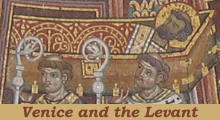 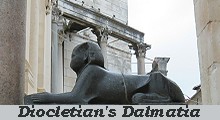  |
